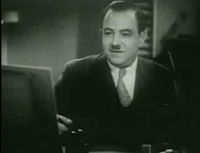Max Fleischer (cartoonist)
Max Fleischer , actually: Maximilian Fleischer , (born July 19, 1883 in Kraków , Austria-Hungary , † September 11, 1972 in Los Angeles , USA ) was an American cartoonist and animation producer of Polish and Jewish descent. The series Betty Boop , Popeye the sailor and Koko the clown , with which he dominated the market until Walt Disney's successes in the 1930s, emerged in his studio .
life and work
Max Fleischer was born as the second son of the tailor Wilhelm (William) Fleischer and his wife Amalia. In 1887 the family emigrated to New York . He attended courses in art and design at the Art Students League , Cooper Union, and Mechanics and Tradesmen's School . In 1905 he married his childhood sweetheart Ethel "Essie" Goldstein.
Fleischer and his younger brother Dave (* July 14, 1894, † June 25, 1979) founded the successful Fleischer Studios in 1921 , which were best known for their cartoons. In the course of their work, they developed the rotoscope - a device with which moving images could be projected onto a drawing table, frame by frame, and thus simplified the production of cartoons. In 1917 he received a patent for it. As early as 1924, Max and Dave Fleischer were the first filmmakers to produce dubbed cartoons with sound, bringing them four years earlier than Disney, as it wasn't until 1928 that Disney could follow with Mickey Mouse in Steamboat Willie . Fleischer retained his Austrian citizenship until 1942, when the Second World War forced him to change his nationality.
Max Fleischer died on September 11, 1972 in Woodland Hills , Los Angeles . Fleischer's son Richard became a successful film director in Hollywood .
literature
- Richard Fleischer: Out of the inkwell . Max Fleischer and the animation revolution. Foreword by Leonard Maltin . University Press of Kentucky, Lexington 2005, ISBN 0-8131-2355-0 .
- Leslie E. Cabarga: The Fleischer Story. A History of the Max Fleischer Cartoon Studio in the Golden Age of Film Animation 1920–1942. Nostalgia Press, New York 1976. (revised edition. Da Capo Press, New York 1988, ISBN 0-306-80313-5 .)
- Ray Pointer: The art and inventions of Max Fleischer: American animation pioneer , Jefferson, North Carolina: McFarland & Company, Inc., Publishers, [2017], ISBN 978-1-4766-6367-8
swell
- ^ Mark Langer: Out of the Inkwell. The cartoons by Max and Dave Fleischer. ( Memento of January 11, 2005 in the Internet Archive ) In: Blimp Film Magazine. No. 26th
- ^ Ray Pointer: The Art and Inventions of Max Fleischer: American Animation Pioneer . McFarland. March 21, 2017. Retrieved October 5, 2017.
- ↑ Bernard Pelletier: Empire Biota: Taxonomy and Evolution 2nd Edition . Lulu.com. March 1, 2012. Retrieved October 5, 2017.
- ↑ Famous Male Animators . Retrieved October 5, 2017.
- ↑ Leslie Cabarga: The Fleischer Story. 1988, p. 10.
Web links
- Mark Langer: Out of the Inkwell. The cartoons by Max and Dave Fleischer. ( Memento of January 11, 2005 in the Internet Archive ) In: Blimp Film Magazine. No. 26. (German)
- 69 cartoons by Max Fleischer (freely accessible)
- Max Fleischer Studio in Don Markstein's Toonopedia (English)
| personal data | |
|---|---|
| SURNAME | Butcher, Max |
| ALTERNATIVE NAMES | Butcher, Maximilian |
| BRIEF DESCRIPTION | American animated film producer |
| DATE OF BIRTH | July 19, 1883 |
| PLACE OF BIRTH | Krakow |
| DATE OF DEATH | September 11, 1972 |
| Place of death | los Angeles |

